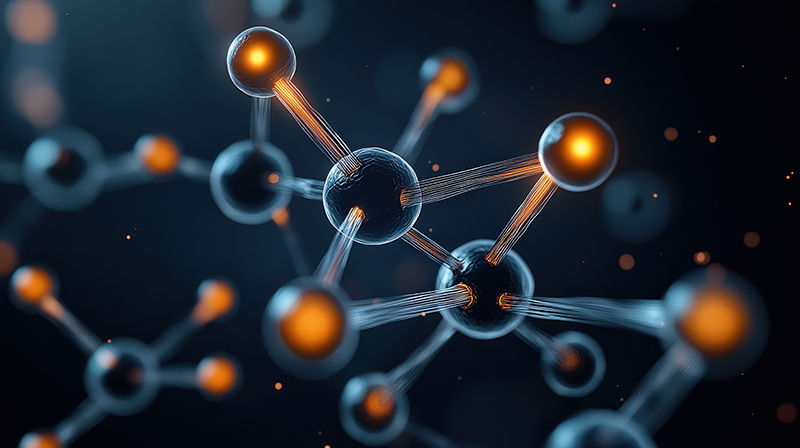

AI and quantum computing hold the promise of revolutionizing industries like materials science, pharmaceuticals, and energy. One of the most compelling frontiers is in designing novel catalysts, the tiny molecular players that accelerate vital industrial processes and drive innovation in sustainable energy and materials. At SandboxAQ, alongside our partners at Dow and IonQ, we are making unprecedented progress in using quantum technologies to design better catalysts that can profoundly impact the chemicals and catalyst industry. This work brings the chemical and materials industries closer to using quantum-enhanced simulations to design more efficient, lower-cost, and environmentally friendlier catalysts.
Current quantum hardware has been limited by noise, a persistent disruptor of delicate quantum states. Rather than seeing this as an immovable barrier, we saw an opportunity. Our latest research, detailed in two collaborative papers entitled: Iterative Qubit Coupled Cluster using only Clifford circuits and Correlating noise floor with magic and entanglement in Pauli product states, demonstrates how we can leverage classical computing to lighten the quantum computational load, thus mitigating noise and enabling the extraction of accurate, usable results that accelerate catalyst discovery. This work underscores the potential of hybrid quantum computing - the integration of classical and quantum computing - to expand the frontiers of real-world scientific computation.
The first breakthrough centered on ground-state energy estimation, a fundamental step in designing catalysts. Building upon an existing method called iterative qubit coupled cluster (iQCC), SandboxAQ introduced a novel approach that uses only Clifford circuits to prepare highly accurate initial states on a classical computer. The resulting circuits can be efficiently simulated according to the Gottesman-Knill theorem, providing a scalable and practical pathway to generate states relevant to complex chemical systems. These states act as an effective launchpad for quantum simulations, dramatically reducing the computational burden on quantum hardware.
Peter Margl, senior computational chemist at Dow explains: “It is important to see these methods applied to industrially relevant chemical systems”. In one of our most exciting demonstrations, we approximated the ground state (i.e., the lowest energy state of a molecule) of a complex catalyst, using a 40-qubit model. Calculating relevant ground states that result in accurate observables is one of the hardest problems in chemistry and physics. To achieve a calculation this large, we drastically improved efficiencies of the method by developing ways to apply general transformations that map complex molecular problems onto reduced spaces. The successful modeling of this complex organometallic compound, in close collaboration with Dow, is a major demonstration for how quantum and classical methods can work in tandem towards solving the next-generation of real world problems.
Yet even with the best state preparation method, noise in current quantum devices is unavoidable. Our second breakthrough involves taking a closer look at the relationship between noise and the resources unique to quantum computation, specifically entanglement and magic, the latter quantifying how "non-Clifford" and classically hard to simulate a state is. “The success of a quantum computation depends not only the qualities of the quantum state, but also on how you choose to extract information from it,” explains Erika Lloyd at SandboxAQ. By analyzing magic and entanglement we demonstrate that low fidelity states, which are typically discarded, can still contain useful information. To harness these resources we use an offline purification method to recover the quantum states, so they can be used in high accuracy calculations. We demonstrate this on IonQ’s ion trap quantum computer, and additionally explore the re-use of experimental data from a single quantum state to calculate the energy of many chemical systems. This opens the door to creating entire libraries of catalyst simulations from just a handful of well-optimized quantum experiments.
Equally significant was our finding that not all quantum states are equally affected by noise. By analyzing when and how magic and entanglement are generated in a quantum circuit, we showed it is possible to design circuits that are intrinsically more resilient. We can now strategically structure operations to minimize noise accumulation, enabling more robust computations. In noisy settings, we were able to design pathways for creating chemical states with reduced noise floor and error rates, even at larger circuit depths. This insight has transformative implications for how we design quantum algorithms in the future. “This changes how we think about designing quantum circuits,” said Joshua Goings at IonQ. “Instead of only trying to use fewer operations, we can also defer the most noise-sensitive quantum effects for the end of the computation.”
As quantum computers scale and noise mitigation techniques like ours continue to mature, we believe we are on the cusp of a new era where AI-driven quantum simulations will become an integral part of industrial R&D pipelines and deliver real-world impact.
In the meantime, scientists can leverage today’s GPU-powered classical computing architectures and powerful quantitative AI modes – Large Quantitative Models, or LQMs – to significantly reduce R&D time for novel catalyst discovery from years to months or weeks, while also reducing cost and risk. In the future, AI-powered classical computers will work in tandem with quantum computers in a hybrid compute environment, taking advantage of the strengths of each to discover, develop, and deliver these catalysts to market.
We are excited by the possibilities this holds for not only catalyst development but also for advancing energy storage, sustainable manufacturing, materials science and pharmaceutical development. If you would like to explore the technical underpinnings of our work, we encourage you to read our full research papers available on arXiv: Correlating noise floor with magic and entanglement in Pauli product states and Iterative Qubit Coupled Cluster using only Clifford Circuits, and feel free to contact us to talk to one of our AI and Quantum experts.